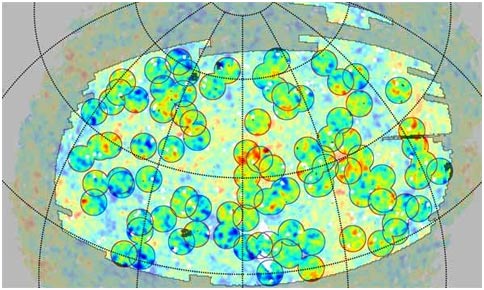Astronomy proves dark energy
Dark energy accounts for 70% of the mass of the universe - and is completely invisible. Even so, scientists have proved it: thanks to what remains from the moment right after the Big Bang.
Statistically speaking, our universe looks like soap bubbles in a bath: the material is unevenly distributed. Many galaxies form a group and then join into super groups. For example, our Milky Way belongs to the Virgo supergroup. Between supergroups is a huge empty space in which the probability of not having one atom in a m 3 .
Until now astronomers have not been able to fully explain this structure. The gravitational force of visible material is not enough to explain the magic structure formed after the Big Bang. And so astronomers believe that there must be another invisible substance - dark energy - that must account for 70% of the universe's mass.
Although the idea of dark energy was convincing, it still lacks a direct demonstration. The research team of Istvan Szapudi from the University of Hawaii was delighted to welcome a breakthrough: "We were able to prove that the dark energy is active while it stretches empty spaces and galactic supergroups" , Szapudi said.
For about 10 years now science has suggested that dark energy works against gravity - and thus is the cause of the accelerated expansion of the universe.

Galactic supergroups and empty spaces (red and blue circles) and microwave radiation: Energy-rich radiation is red and orange, colder in green and blue areas .(Photo: IFA Hawaii)
Szapudi and his colleagues demonstrated dark energy through the change of cosmic microwave background radiation, remnants of the Big Bang. They argue that radiation is everywhere, through super groups and similar spaces. When passing through a group of galaxies, microwave radiation receives a little more energy.
On a map of cosmic microwave radiation, scientists drew known galaxies and empty spaces. Thereby they realized that radiation actually has a small amount of extra energy when it passes through a galaxy. The opposite effect through an empty space can be seen.
"With this method we can for the first time see empty gaps and galaxies do with microwave radiation through them," said Benjamin Granett of the research team.
Scientists believe that the effect they observe actually exists and is not random and will publish results in the " Astrophysical Journal Letters " magazine.
Simon White of the Max Planck Institute for Astrophysics in Garching (Germany) praised the team's results from Hawaii. " This analysis is probably right ." However, according to him, this is not a breakthrough. For him, the existence of dark energy has been proven long ago - from the perception of the universe's accelerated expansion 10 years ago.
Phan Ba - Vnexpress (According to Online Spiegel)
- The mystery of dark energy
- Study the 'dark energy' source in the galaxy
- Camera 'Terror' hunts dark energy
- Astronomy with new fields: Dark matter
- The dark energy tracing project will help find the 9th planet
- The physics king Hawking talks about dark matter
- What is dark energy?
- Detecting the risk of dark energy
- The world's most powerful digital camera hunts for dark energy
- Dark camera 'hunting'
- New theory rejects dark energy
- Many scientists object to the new theory of denying dark matter and dark energy
 Van Allen's belt and evidence that the Apollo 11 mission to the Moon was myth
Van Allen's belt and evidence that the Apollo 11 mission to the Moon was myth The levels of civilization in the universe (Kardashev scale)
The levels of civilization in the universe (Kardashev scale) Today Mars, the sun and the Earth are aligned
Today Mars, the sun and the Earth are aligned The Amazon owner announced a secret plan to build a space base for thousands of people
The Amazon owner announced a secret plan to build a space base for thousands of people